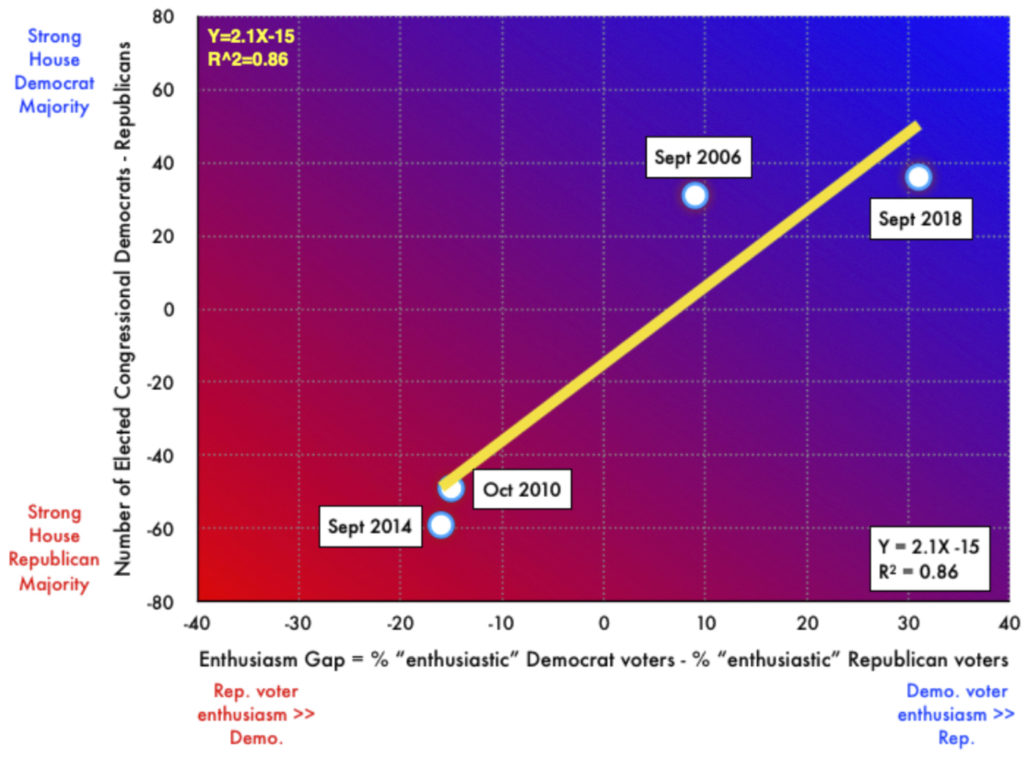An Electoral Prediction Made on 9/21/2022
As the percent of Democrats (51%) and Republicans (52%) saying they are “almost certain” to vote is approximately equal, the below equations predict that the Republicans will control the House of Representatives in 2023 with a majority of about 10-17 seats.
As of 12/4/2022, the Republicans will control the House of Representatives with a majority of about 8-10 seats.
—————
It is common knowledge that voter “enthusiasm” has an influence on the outcomes of elections. By cross correlating polling data which assesses pre-election voter enthusiasm versus election outcomes in the House of Representatives I was able to derive a simple equation which appears to provide prognostic information as to which party will win control of the House of Representatives and by how much.
Voter “enthusiasm” polling data was obtained from Pew Research Center. Their typically “enthusiasm” polling question is “Are you more enthusiastic about voting than usual?” This data is subdivided into Republican voters and Democrat voters. One can use this data to calculate the “enthusiasm gap” which is equal to the percent of enthusiastic Democrat voters minus the percent of enthusiastic Republican voters. Thus, a positive enthusiasm gap implies that enthusiasm among Democrats exceeds the enthusiasm among Republican voters. Conversely a negative enthusiasm gap implies the Republican voters are more enthusiastic.
Using the House of Representatives elections results from September 2006, October 2010, September 2014, and September 2018, I plotted the enthusiasm gap on the X-axis vs the number of elected House Democrats minus the number of elected House Republicans on the Y axis. (Note: All Representatives run for re-election every 2 years.) I curve-fit this data to a straight line and we see that 1) the derived equation of the line has a high R^2 value and 2) the line cross very close to the origin coordinates (0,0) as would rationally be expected. Both points lending credence to the validity of the equation. (Apologies to the statisticians.)

Using the derived equation shown in the bottom right corner of graph and “enthusiasm” polling data obtained 1-2 months prior to the election, one should be able to predict the approximate number of Republicans and Democrats who will be in next session of the House of Representatives.
Hayward Zwerling
1/31/2020
———
Addendum posted 8/28/2022
I have updated the correlation graph with additional “enthusiasm” polling data obtained from Pew Research Center shortly prior to the 2020 election and additional pre-election “enthusiasm” polling data from Gallup.
Unfortunately it appears that if the “enthusiasm” for the Democrat and Republican candidates are the same, then the Republicans will control the House of Representatives by 8 seats.

Of course, mixing polling data from Pew Research Center and Gallup introduces an additional source of error as their polling methodologies are not identical. If we looked only at the 5 Pew Research Center data points, we get Y=2.09*X – 10.6 and R2 =0.822. Again, if the “enthusiasm” of the Democrat voters is identical to the Republican voters, the Republicans are predicted to control the House of Representatives by 11 seats.
Hayward Zwerling
8/28/2022
